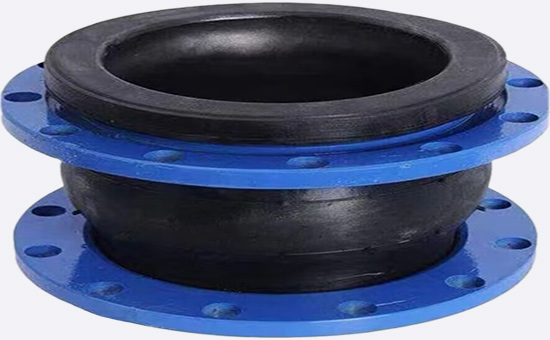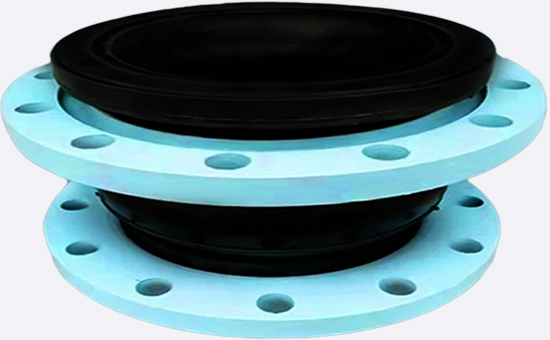
Oil-resistant rubber soft joints are important components used in various oil environments, composed of inner rubber, outer rubber, cord skeleton, steel wire ring, flange, general inner layer of rubber, outer layer of rubber are made of nitrile rubber or neoprene as the main raw material, with good elasticity, oil resistance, aging resistance, etc. As the main treatment method of waste rubber, reclaimed rubber is widely used in the production of various rubber products to improve economic benefits. So can reclaimed rubber be used in the production of oil-resistant rubber soft joints to reduce costs?
Oil-resistant rubber soft joints have strict requirements for the oil resistance of rubber compounds, and it is recommended to use nitrile reclaimed rubber with excellent oil resistance when using reclaimed rubber to reduce its production cost. The performance requirements of different parts of rubber joints are different, and the performance requirements of rubber joints in different adaptable occasions are also different. Therefore, when using nitrile reclaimed rubber to reduce the production cost of oil-resistant rubber soft joints, it is necessary to select suitable reclaimed rubber products according to the physical properties of rubber joints, and adjust the rubber compound formula and skeleton material varieties.
1. Tips for choosing reclaimed rubber for oil-resistant rubber soft joints
When using nitrile reclaimed rubber to produce oil-resistant rubber soft joints, the quality of the reclaimed rubber is crucial to the performance of the rubber joints. First, it is necessary to evaluate whether the reclaimed rubber can meet the specific application requirements of rubber joints. Secondly, to ensure the stable quality and reliable source of nitrile reclaimed rubber, choose to cooperate with a regular reclaimed rubber factory that can provide relevant test reports; In addition, considering whether the reclaimed rubber is susceptible to aging and oxidation, appropriate aging tests and oxidation stability assessments should be carried out before using the reclaimed rubber.
2. Oil-resistant rubber soft joints are mixed with reclaimed rubber vulcanization formula adjustment
When using nitrile reclaimed rubber to produce oil-resistant rubber soft joints, nitrile reclaimed rubber and nitrile original rubber can be used together in an appropriate ratio, or nitrile rubber/nitrile reclaimed rubber/neoprene rubber can be used together to further improve the elasticity and oil resistance of rubber joints. Considering the performance indicators and cost budget of rubber soft joints, it is recommended to gradually increase the proportion of reclaimed rubber under the premise of ensuring performance.

The oil-resistant rubber soft joints mixed with reclaimed rubber can choose sulfur-accelerator system, and the vulcanized rubber has high mechanical strength; The accelerator M, accelerator D, accelerator DM, accelerator TMTD, zinc oxide and stearic acid are used as vulcanization active agents to increase the crosslinking density and improve the oil resistance and heat resistance of nitrile reclaimed rubber 2SLYY1221 vulcanized rubber. The use of carbon black or silica reinforcement can not only improve the mechanical properties, but also improve the oil resistance of the rubber compound of oil-resistant rubber soft joints. It is recommended to use low-molecular weight polyethylene, oxidized polyethylene, coumarone, polyester plasticizer and liquid rubber with large molecular weight, low volatility and not easy to be extracted by oil.
3. The inner rubber of oil-resistant rubber soft joints is mixed with nitrile reclaimed rubber vulcanization formula
20 parts of nitrile rubber, 30 parts of nitrile reclaimed rubber, 50 parts of neoprene, 5 parts of zinc oxide, 1.5 parts of stearic acid, 4 parts of magnesium oxide, 1 part of antioxidant A, 1 part of antioxidant D, 1 part of paraffin, 10 parts of dibutyl phthalate, 35 parts of carbon black N774, 20 parts of light calcium, 5 parts of coumarone resin, 1 part of accelerator CZ, 1 part of accelerator DM, 0.3 parts of accelerator TMTD, 1 part of sulfur; Total: 186.8 shares. Vulcanization time temperature: 153°C 15min.
The performance requirements of the inner and outer rubber layers of oil-resistant rubber soft joints are different, and the mixing ratio and mixing method of reclaimed rubber are different, which need to be adjusted according to the specific product requirements and the characteristics of the reclaimed rubber; Factors such as production processes, costs, and environmental factors also need to be considered. The rational use of reclaimed rubber in the oil-resistant rubber soft joints, the finished product has good oil resistance, aging resistance, weather resistance, etc., and can well adapt to the use environment of hydraulic oil, petroleum, engine oil, diesel, lubricating oil, etc., and do not cause cracking, corrosion, swelling and other problems when used in oil medium for a long time; Effectively reduce production costs and improve economic benefits.
Exclusive original article [commercial authorization] reprint, excerpt and excerpt in any form are prohibited without written authorization. Focus on Hongyun rubber: learn the process formula and raw material technology of producing rubber products from recycled rubber to help you reduce costs and increase profits